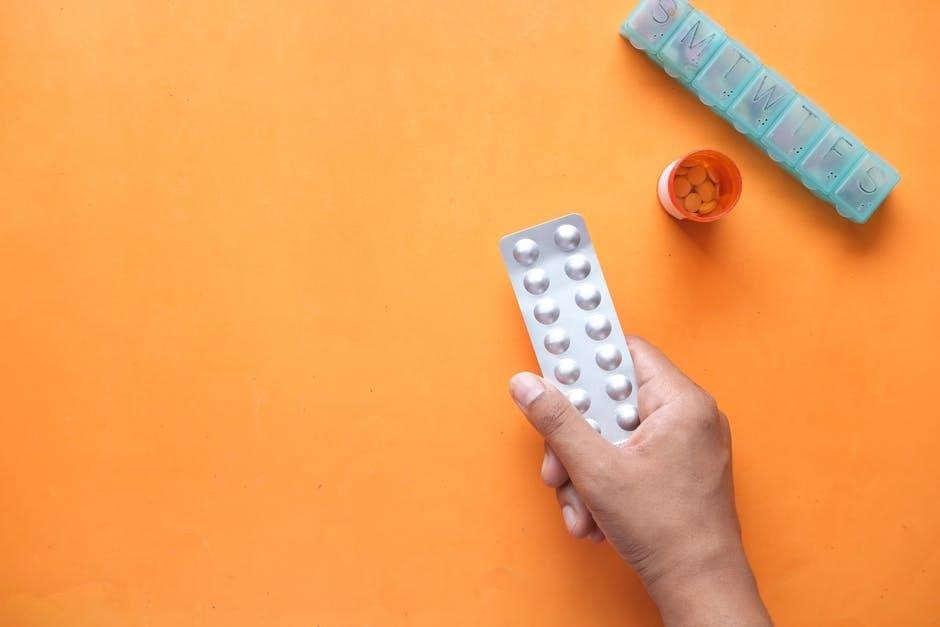
medrol dose pack instructions pdf
The Medrol Dose Pack contains methylprednisolone, a corticosteroid used to treat inflammatory conditions like arthritis, asthma, and allergies. It provides a 6-day tapered dose regimen to reduce inflammation effectively.
What is Medrol Dose Pack?
The Medrol Dose Pack is a pre-packaged, 6-day taper schedule of methylprednisolone, a corticosteroid used to treat inflammatory and autoimmune conditions. It contains 21 tablets, with doses decreasing from 6 tablets (24 mg) on Day 1 to 1 tablet (4 mg) on Day 6. This graduated dosing helps reduce inflammation and immune responses effectively. The pack is designed for convenience, ensuring patients follow the correct dosage without needing to adjust prescriptions. It is commonly prescribed for conditions like arthritis, asthma, severe allergies, and certain skin or respiratory disorders. The Medrol Dose Pack is a popular choice due to its ease of use and effectiveness in managing acute inflammatory episodes.
Purpose and Uses of Medrol Dose Pack
The Medrol Dose Pack is primarily used to treat various inflammatory and autoimmune conditions by reducing swelling and suppressing the immune system. Its purpose is to provide a tapered dose of methylprednisolone, a corticosteroid, to effectively manage acute episodes of conditions such as rheumatoid arthritis, lupus, psoriasis, and severe allergic reactions. It is also utilized for respiratory issues like asthma and certain skin disorders. The pack is designed to deliver high doses initially, which are gradually reduced over six days, minimizing potential side effects. This approach helps patients recover quickly from inflammation without the need for long-term steroid use. The Medrol Dose Pack is a convenient and effective treatment option for short-term management of inflammatory conditions, offering both patient convenience and therapeutic efficacy.

Dosage Instructions
The Medrol Dose Pack provides a 6-day tapered dosing schedule, starting with 6 tablets on Day 1 and gradually reducing daily to minimize side effects and inflammation effectively.
Day 1: Initial Dose
On Day 1, patients are instructed to take all six 4mg tablets at once, preferably in the morning, with a glass of water and food if needed to avoid stomach upset. This initial high dose helps quickly reduce inflammation and manage symptoms effectively. It’s crucial to follow this step as directed to ensure the treatment’s efficacy and minimize potential side effects.
Day 2: Continued Dose
On Day 2, patients should take five 4mg tablets following the same instructions as Day 1. This step continues the high-dose regimen to maintain therapeutic effects. Consistency is key to effectively managing inflammation and symptoms. Taking the tablets in the morning with food, if needed, helps reduce stomach discomfort. Patients should adhere strictly to the prescribed schedule to avoid any interruptions in treatment. It’s important to note that abruptly stopping the medication can lead to withdrawal symptoms, so completing the full course is essential for optimal results.
Day 3: Adjusted Dose
On Day 3, the dose is reduced to four 4mg tablets. Patients should continue following the prescribed schedule, taking the tablets either all at once in the morning or divided throughout the day with food to minimize stomach discomfort. Consistency in dosing is crucial to maintain therapeutic effects and prevent inflammation flare-ups. It’s important to adhere to the adjusted dose and avoid skipping or doubling doses. Patients should not stop the medication abruptly, as this may lead to withdrawal symptoms. Completing the full course as directed ensures the inflammation is adequately controlled. If any issues arise, consulting a healthcare provider is recommended to address concerns and maintain treatment effectiveness.
Day 4: Further Adjustments
On Day 4, the dose is further reduced to three 4mg tablets. Patients should continue to follow the prescribed schedule, taking the tablets either all at once in the morning or divided throughout the day with food to minimize stomach discomfort. It is important to adhere to the adjusted dose and avoid skipping or doubling doses. Consistency in dosing is crucial to maintain therapeutic effects and prevent inflammation flare-ups. Patients should not stop the medication abruptly, as this may lead to withdrawal symptoms. Completing the full course as directed ensures the inflammation is adequately controlled. If any issues arise, consulting a healthcare provider is recommended to address concerns and maintain treatment effectiveness.
Day 5: Reduced Dose
On Day 5, the dose is reduced to two 4mg tablets. Patients should continue to follow the prescribed schedule, taking the tablets either in the morning or divided throughout the day with food to minimize stomach discomfort. It is important to adhere to the adjusted dose and avoid skipping or doubling doses. Consistency in dosing is crucial to maintain therapeutic effects and prevent inflammation flare-ups. Patients should not stop the medication abruptly, as this may lead to withdrawal symptoms. Completing the full course as directed ensures the inflammation is adequately controlled. If any issues arise, consulting a healthcare provider is recommended to address concerns and maintain treatment effectiveness. Staying on track with the dose pack instructions ensures the best possible outcome for managing inflammatory conditions.
Day 6: Final Dose
On Day 6, patients take the final dose of 1 tablet (4mg) as directed. It is recommended to take the tablet in the morning with food to minimize stomach discomfort. This concludes the 6-day tapered regimen. Patients should not exceed the prescribed dose or extend the treatment without medical advice. Abruptly stopping the medication may lead to withdrawal symptoms, so it is crucial to follow the prescribed schedule. After completing the dose pack, any unused tablets should be discarded. If symptoms persist or worsen, patients should contact their healthcare provider for further guidance. Completing the full course ensures the inflammatory response is adequately managed. Patients are advised to monitor for any side effects and report them to their doctor if they occur. This final dose marks the end of the treatment cycle, and follow-up appointments may be necessary to assess treatment effectiveness.

Administration Tips
Take Medrol Dose Pack tablets with food or milk to reduce stomach upset. Always follow the prescribed schedule and complete the full course to ensure effectiveness and minimize side effects.
When to Take the Medication
It is recommended to take the Medrol Dose Pack in the morning to minimize the risk of insomnia. If the dose pack is received later in the day, it is acceptable to consume all tablets on the first day either at once or in divided doses; Consistency in timing helps maintain therapeutic effectiveness. Always take the medication with food or milk to reduce the risk of stomach upset. Follow the prescribed schedule strictly, as sudden stopping can lead to withdrawal symptoms. Adjustments should only be made under medical supervision. Adherence to the dosing regimen ensures optimal results and minimizes potential side effects.
How to Take the Tablets
Medrol Dose Pack tablets should be taken as directed on the packaging or by your healthcare provider. On Day 1, you may take all 6 tablets at once or split them into multiple doses throughout the day. It is advisable to take the tablets with a glass of water and food to reduce the risk of stomach upset. For subsequent days, follow the prescribed dosing schedule, which tapers the number of tablets gradually. Do not stop taking the medication abruptly, as this may lead to withdrawal symptoms. If you miss a dose, take it as soon as you remember unless it is close to the next dose. Always swallow the tablets whole and avoid crushing or chewing them. If you have difficulty swallowing, consult your doctor for guidance. Adhere to the instructions carefully to ensure the medication works effectively.
Importance of Completing the Full Course
Completing the full course of the Medrol Dose Pack is crucial for effectively managing inflammatory conditions. The regimen is designed to gradually reduce the dose over six days, allowing your body to adjust and minimizing potential side effects. Stopping the medication early may lead to incomplete resolution of symptoms or rebound inflammation. It is essential to follow the prescribed schedule and not skip or discontinue doses without medical advice. If you experience side effects or concerns, consult your healthcare provider for guidance rather than stopping on your own. Adhering to the full course ensures the medication works as intended to suppress inflammation and prevent relapse. Proper completion helps achieve optimal therapeutic benefits and supports overall recovery.

Important Considerations
The Medrol Dose Pack may cause side effects like insomnia, mood changes, or water retention. Always follow the prescribed regimen and avoid sudden discontinuation to prevent withdrawal symptoms. Consult your healthcare provider if you experience adverse effects or intolerance.
Missed Doses and What to Do
If a dose of Medrol Dose Pack is missed, take it as soon as remembered unless it is close to the next dose. Do not double up on doses to compensate for a missed one. Patients should continue with their regular dosing schedule. If multiple doses are missed, consult a healthcare provider for guidance. It is important to complete the full course of medication as prescribed to ensure effectiveness and prevent potential withdrawal symptoms. Sudden stopping of the medication can lead to adverse effects, so any changes should be discussed with a doctor. Proper adherence to the dosing regimen is crucial for optimal therapeutic outcomes and minimizing side effects.
Possible Side Effects
The Medrol Dose Pack may cause several side effects, which are generally mild and temporary. Common side effects include insomnia, mood changes, increased appetite, and water retention. Some patients may experience dizziness, headache, or stomach upset. In rare cases, more serious side effects such as vision problems, severe allergic reactions, or increased blood sugar levels can occur. If any unusual or severe symptoms arise, patients should seek medical attention immediately. Long-term use of corticosteroids can lead to additional side effects, such as adrenal suppression or osteoporosis, but the short-term use of the Medrol Dose Pack minimizes these risks. It is important to discuss any concerns or pre-existing conditions with a healthcare provider before starting the medication. Patients should also report any persistent or worsening symptoms during or after the treatment course.
Contraindications and Warnings
The Medrol Dose Pack is contraindicated in patients with known hypersensitivity to methylprednisolone or other corticosteroids. It should not be used in individuals with certain infections, such as untreated fungal or bacterial infections, unless directed by a healthcare provider. Caution is advised in patients with a history of diabetes, as corticosteroids may affect blood sugar levels. Additionally, individuals with high blood pressure, heart disease, or liver disease should use this medication with caution. Women who are pregnant or breastfeeding should consult their doctor before taking the Medrol Dose Pack. The medication should be used with caution in the elderly and in those with a history of mental health conditions, as corticosteroids can exacerbate these issues. Patients should avoid live vaccines while on this medication and inform their healthcare provider of any recent vaccinations. Adverse effects may be more pronounced in these populations, requiring close monitoring and dose adjustments as needed.

Patient Experiences
Patients often report insomnia as a common side effect, while others prefer Medrol over Prednisone due to fewer side effects like moon face or increased appetite.
Common Patient Feedback
Patients commonly report that the Medrol Dose Pack is effective for managing inflammatory flares, with many preferring it over Prednisone due to fewer side effects. Some note insomnia as a frequent issue, while others appreciate the lack of significant appetite changes or moon face, which are often associated with higher steroid doses. Overall, the convenience of the tapered regimen is well-received, though a few find the packaging instructions confusing. Many emphasize the importance of taking the medication as directed to avoid withdrawal symptoms. While side effects like mild edema or flushed faces occur, they are generally tolerable. Patients also highlight the medication’s ability to quickly reduce inflammation and improve symptoms, making it a preferred option for short-term use.
Tips from Patients
Patients who have used the Medrol Dose Pack often share practical advice for optimal use. Many recommend taking the first day’s tablets as soon as possible, even if received later in the day, to align with the intended regimen. Others suggest taking the morning dose earlier to minimize insomnia. Starting the pack at the first sign of a flare-up is frequently advised to prevent symptoms from worsening. Some patients emphasize the importance of following the tapered dosing schedule to avoid withdrawal symptoms. Additionally, they recommend consulting a healthcare provider before stopping the medication early. Foods or anti-acids may help alleviate stomach discomfort, and staying hydrated is encouraged. Overall, patient tips highlight the importance of adherence and proactive management of potential side effects.
Managing Side Effects
Common side effects of the Medrol Dose Pack include insomnia, mood changes, increased appetite, and water retention. To manage these, patients often recommend taking the medication in the morning to reduce nighttime restlessness. Staying hydrated and maintaining a balanced diet can help mitigate water retention and swelling. Some users suggest monitoring sodium intake to minimize bloating. For mood swings or irritability, engaging in relaxing activities or communicating openly with family and friends can be beneficial. If insomnia persists, avoiding caffeine and electronic devices before bedtime may help improve sleep quality. It’s important to discuss any severe or persistent side effects with a healthcare provider, as they may adjust the dosage or recommend additional strategies to manage discomfort;

Medical Guidance
Consult healthcare providers before starting the Medrol Dose Pack, especially for contraindications or interactions. Follow their advice for dosage adjustments and monitor for side effects. Contact emergency services if severe reactions occur.
Consulting Healthcare Providers
Consulting healthcare providers is crucial before starting the Medrol Dose Pack. They will assess your condition and determine the appropriate dosage, ensuring safe and effective treatment. Discuss your medical history, including any allergies or current medications, to avoid potential interactions. Providers may adjust the dose based on your response and overall health. Regular follow-ups are recommended to monitor progress and address any concerns. If you experience side effects or have questions, contact your provider promptly. Their guidance ensures you use the medication correctly and safely, minimizing risks and maximizing benefits. Always follow their instructions to achieve the best outcomes with the Medrol Dose Pack.
Emergency Contact Information
Emergency Contact Information
In case of severe side effects or allergic reactions, contact your healthcare provider immediately. For life-threatening situations, call emergency services. Key contact numbers include:
- Pacific Neuroscience Institute: 310-829-8701
- Playa Vista: 424-443-5530
- Saint Johns Medical Plaza: 310-829-7792
- Torrance: 310-829-7792
- Brentwood: 310-477-5558
If you experience unbearable side effects or cannot tolerate the medication, contact our office at 801-747-1020. For non-emergencies, consult your provider for adjustments or alternatives. Always seek professional advice for severe reactions to ensure timely intervention and proper care.
Follow-Up Appointments
After completing the Medrol Dose Pack, it is crucial to schedule a follow-up appointment with your healthcare provider to monitor your condition and ensure the medication was effective. This visit allows your doctor to assess whether symptoms have improved or if further treatment is needed. Be prepared to discuss any side effects experienced during the course of treatment. Your provider may adjust your treatment plan based on your response to the medication. Regular follow-ups are essential for managing chronic conditions and preventing flare-ups. If you notice persistent or worsening symptoms, contact your healthcare provider promptly to avoid complications. Follow-up appointments are a key part of ensuring your overall health and well-being after using the Medrol Dose Pack.

Additional Resources
For more detailed information, visit the manufacturer’s official website or download the Medrol Dose Pack instructions PDF from reliable medical platforms like HelloPharmacist or Pacific Neuroscience Institute.
Where to Find More Information
For comprehensive details on the Medrol Dose Pack, visit the manufacturer’s official website or consult reliable medical platforms like HelloPharmacist or Pacific Neuroscience Institute. Additional resources include downloadable PDF instructions available on trusted healthcare sites. Patients can also contact their local pharmacy or healthcare provider for printed guides. Online forums and support groups, such as those linked on medication information portals, offer real-world insights from users. Ensure to verify sources for credibility, as accurate information is essential for proper usage. Links to official Medrol Dose Pack guidelines can also be found on pharmaceutical company websites or through medical institute resources.
Downloadable PDF Instructions
Downloadable PDF instructions for the Medrol Dose Pack are readily available on the manufacturer’s official website and other trusted medical resources. These PDF guides provide detailed dosing schedules, administration tips, and safety precautions. Patients can easily access and print these documents for quick reference. The PDFs typically include day-by-day dosing instructions, starting with 6 tablets on Day 1 and tapering down to 1 tablet by Day 6. They also cover important information about potential side effects, contraindications, and what to do if a dose is missed. Additionally, some PDFs offer visual aids, such as tables or charts, to help patients adhere to their medication regimen. Always ensure the PDF is from a verified source, such as the pharmaceutical company or a reputable healthcare provider, to guarantee accuracy and safety.